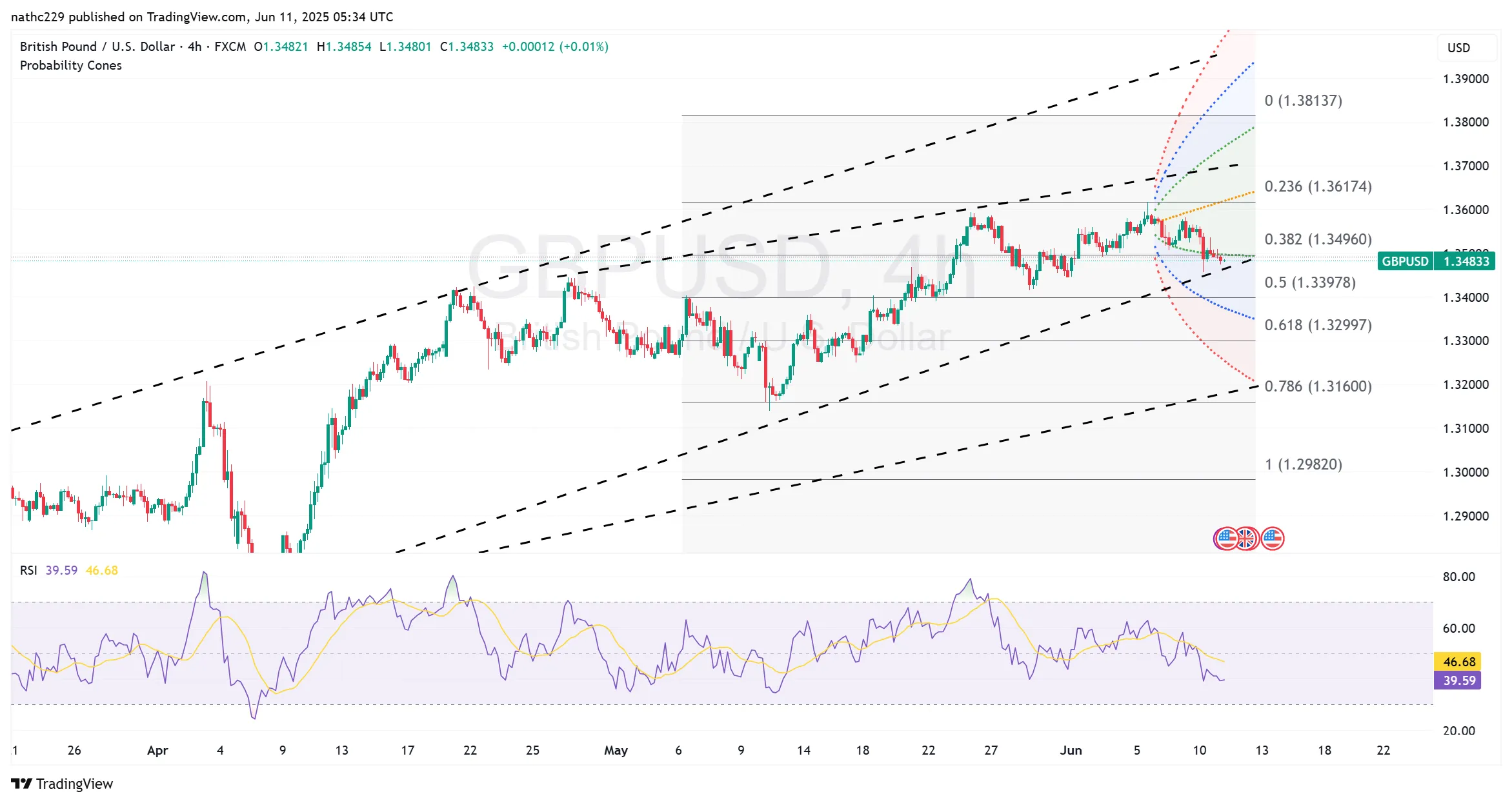
Sterling Slides as UK Labour Market Weakens
Sterling Slides as UK Labour Market Weakness Underscores Growing Risks for BoE Rate Path
UK Payroll Data Intensifies Sterling’s Bearish Outlook
Sterling came under renewed pressure on Tuesday, sliding to a low of 1.3458 and closing down 0.39% at 1.3495, as significantly weaker-than-expected UK payroll data for May amplified concerns regarding the British economic outlook. The May payroll data revealed a considerable decline in new job additions, undershooting expectations markedly, while April’s previously reported figures saw a substantial downward revision. Additionally, average earnings growth slowed more than anticipated, highlighting potential strains on consumer spending amid persistent inflationary pressures.
This combination of weakening employment and earnings growth may have crucial implications for monetary policy, significantly affecting market sentiment. Investors and market participants have promptly interpreted the soft labour market data as likely to prompt the Bank of England (BoE) toward adopting a more dovish stance, potentially accelerating rate cuts during the latter half of 2025. Futures markets now price in an increased likelihood of at least two further BoE cuts before year-end, significantly diverging from the more stable rate outlook priced into the U.S. Federal Reserve’s policy trajectory.
Fed vs. BoE Divergence Reinforces Bearish Sterling Bias
The diverging monetary policy expectations between the BoE and the Fed have increasingly become a critical factor driving GBP/USD price action. While UK data is deteriorating, recent U.S. labour market strength, demonstrated by robust payrolls and higher-than-forecast earnings growth, has notably firmed investor expectations that the Fed will hold rates steady for longer. Consequently, the dollar has found renewed support, notably after the U.S. employment report showed job gains of 139,000 for May, comfortably above consensus forecasts, while average hourly earnings grew 0.4% month-over-month, surpassing market expectations.
Given these dynamics, the Fed’s relatively hawkish stance starkly contrasts with mounting expectations for further rate reductions from the BoE. These divergent trajectories not only exacerbate downward pressure on sterling but also amplify volatility. With the Fed maintaining a cautious yet steady stance against inflationary pressures, and the UK economy visibly losing momentum, GBP/USD has sharply retreated from its recent 2025 high at 1.3616 set on June 5, reflecting heightened market nervousness around sterling exposure.
Key Economic Indicators: US CPI and UK GDP in Focus
The market’s immediate attention now shifts toward two crucial economic indicators that will undoubtedly shape short-term GBP/USD trends. First is Wednesday’s U.S. CPI report, which traders are closely monitoring to gauge inflationary pressures and potential Fed responses. A hotter-than-expected U.S. inflation reading could reinforce expectations for the Fed to maintain a restrictive monetary policy stance, further boosting dollar strength at sterling’s expense.
Conversely, Thursday’s UK GDP report for April will be critical in assessing the full extent of the recent economic slowdown. Any additional signs of economic contraction or stagnation would intensify market fears, pushing the BoE toward a decisively more dovish policy stance. Considering that markets are already nervous following the weak payroll and earnings data, disappointing GDP figures could accelerate selling pressure on sterling, potentially leading GBP/USD toward mid-May lows near 1.33 or even below.
Risks and Consequences of Persistent Economic Weakness
The implications of continued UK economic weakness are substantial. Persistent labour market deterioration could severely dampen consumer spending and investment, exacerbating stagflationary risks. Moreover, prolonged economic softness may negatively impact confidence in the BoE’s ability to manage economic stability through monetary policy, potentially triggering capital outflows from UK assets.
Additionally, heightened market volatility surrounding U.S.-China trade tensions under President Trump’s administration further complicates the outlook. While trade uncertainties historically supported sterling against the dollar due to broader USD weakness, a scenario of renewed trade optimism could paradoxically exacerbate sterling weakness by strengthening the dollar, driven by capital inflows into U.S. assets perceived as more secure.
Technical Levels and Market Factors
From a technical perspective, immediate GBP/USD support lies at Tuesday’s intraday low of 1.3458 and the pivotal 21-day moving average near 1.3453. A decisive break below these levels could open up downside momentum, targeting more critical support near the daily baseline around 1.3378. Conversely, resistance remains firmly established at the 100-hour moving average at 1.3524, Tuesday’s session high of 1.3563, and notably at the upper 30-day Bollinger Band situated at 1.3635.
In conclusion, GBP/USD currently faces significant downside risks, driven by diverging central bank policies, weakening UK economic fundamentals, and increasing market uncertainty. Investors should carefully monitor upcoming economic data points and central bank rhetoric, remaining cautious given the potential for heightened volatility and further sterling depreciation.
